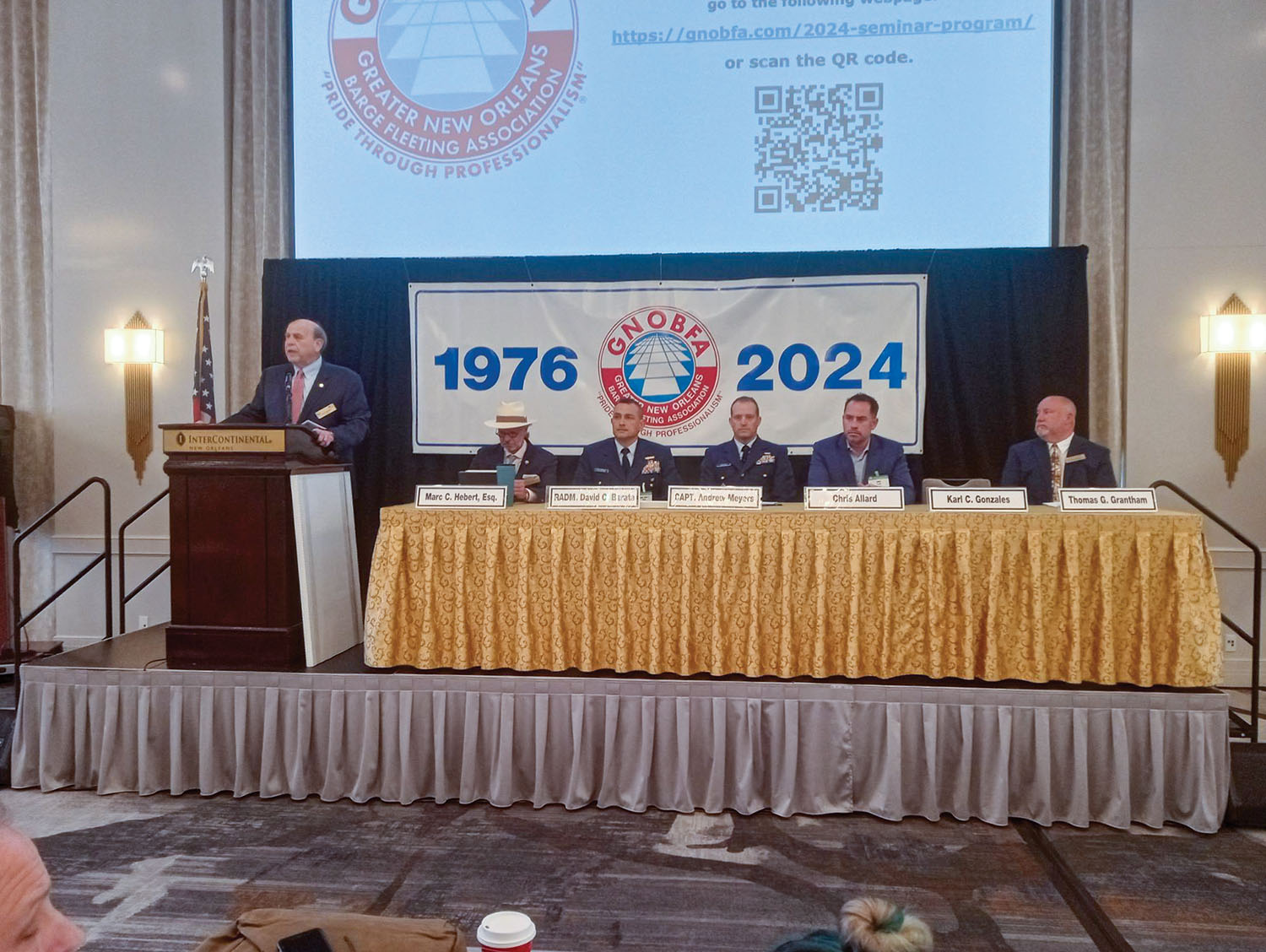“Is it really possible that an autonomous vessel using AI [artificial intelligence] could learn what an experienced vessel captain knows?” wondered Alan Savoie, co-organizer of the 40th Greater New Orleans Barge Fleeting Association River and Marine Industry Seminar, from the floor on the seminar’s first full day.
“Yes, it’s not only possible, it’s inevitable,” answered Chris Allard, CEO of Metal Shark. Allard was one of a panel that included Rear Adm. David Barata, commander of the Eighth Coast Guard District; Capt. Andrew Meyers, chief of port and facility compliance for the Coast Guard; and moderator Marc Hebert, a senior partner at Jones Walker. Attendees at the seminar had just watched a short video highlighting autonomous vessels that Metal Shark is building for the U.S. Navy. The panel’s theme was, “Coming Alternative Technologies for the Marine Transportation System.”
This year about 400 people from 32 states attended the GNOBFA seminar, which offers focused presentations on maritime law, marine insurance and other topics of interest to barge and fleet operators. “This seminar is for the industry and the Coast Guard,”Hebert said in his opening remarks as seminar moderator.
Metal Shark’s towable mini-submersible autonomous vessels, called the Prowler, are designed to perform a variety of missions. They can operate like conventional surface vessels, but they can also partly submerge to lower their radar profile and increase stealth. They can be configured to carry landing vehicles on their decks. Some have already been placed in service with the Marine Corps. Allard said the technology that allows them to operate autonomously will percolate down to commercial vessels eventually.
Allard said that “remote control” and “autonomous” do not mean quite the same thing. Autonomy means the vessel has the ability to make a decision without being directed from elsewhere. That ability does not necessarily have to come from AI; software can be programmed with data from with COLREGS (Convention on the International Regulations for Preventing Collisions at Sea). The cost of the software and chips that power such autonomy is steadily decreasing, Allard said. In years to come, such capabilities may be built into a console and may be turned on or off. Growth in networking and bandwidth increases will change the ability of inland vessels to talk to each other. Tug-and-barge combination vessels could be docked and joined remotely using ball-and-socket joints. “Autonomous doesn’t have to mean no personnel,” he said. It could be “supervised autonomy,” with a captain on board to watch the screens and intervene if necessary.
Alternate Fuels, Cybersecurity
Barata was standing in for Rear Adm. Wayne Arguin, assistant commandant for prevention policy at the U.S. Coast Guard, who was called away at the last minute. “We are moving to an age of dual-powered and battery-powered vessels,” he said, adding that Coast Guard personnel will have to learn how to inspect them. “The waterways we have are finite, but the number of users will continue to grow, and they will all have to agree on the new facilities that will be required to service these new fuels and technologies.” He mentioned larger container ships that can carry 20,000 twenty-foot equivalent units [TEUs], and passenger vessels that can carry 10,000 passengers. “Container yards use GPS to move their containers around efficiently, but the more efficient and connected they become, the more vulnerable they are to cyber threats.”
Meyers said cyber threats take up 80 percent of his time these days. “Every port has its MTS cyber specialist,” he said. The Coast Guard is still receiving comments on a final rule for cybersecurity; no date has been set for publication yet. “We are still coming up with a game plan to make sure our workforce is technically able to evaluate cyber plans. It’s possible third parties might be involved.” Allard said cybersecurity standards are being driven by the banking and insurance sectors, whose security often surpasses that of federal agencies.
Hydrogen One Progress
Beau Berthelot, senior accountant at Maritime Partners (and “recovering attorney,” he said to laughter), spoke from the audience about the progress of the Hydrogen One, Maritime Partners innovative hydrogen-powered towboat that is still in the design stage. It will be designed to extract hydrogen from methanol and water, using 10 hydrogen generators and 10 fuel cells, all cross-connected. Its scheduled route between Baton Rouge and Houston will pass by three methanol producers, so fuel access will not be a problem. Once operational, it will eliminate 99 percent of regulated carbon emissions.
“I was bearish on renewables 10 years ago,” Allard said. “But Europe has reached a level of electrical saturation, with electrolytes being used at the base of windmills to generate hydrogen from boiling ocean water.” He said batteries are only ready for fringe applications now. His company recently was asked to quote an all-electric ferry, which wound up estimated at many times the typical $6-7 million cost of a conventionally powered ferry.
Caption for photo: Karl Gonzalez welcomes attendees to the 40th Annual seminar of the Greater New Orleans Barge Fleeting Association in New Orleans on April 24. (Photo by David Murray)




